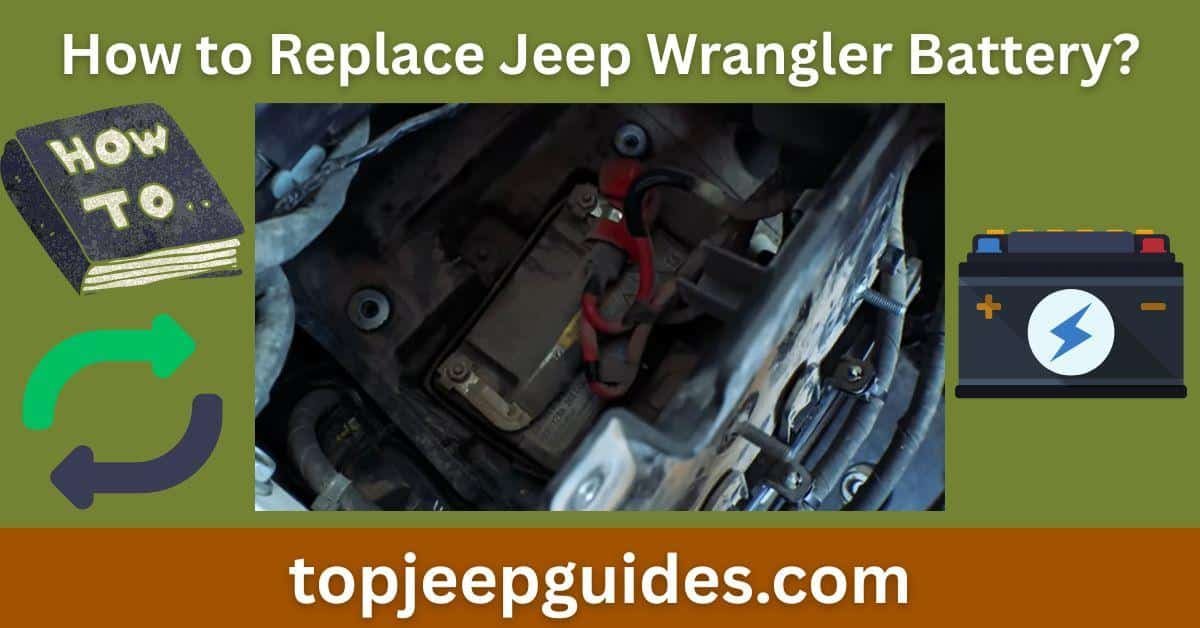How to Replace Jeep Wrangler Battery? (Easy Step-by-Step Guide)

Imagine this: You’ve planned an adventurous day, ready to hit the rugged trails with your trusty Jeep Wrangler. You’ve packed your gear, zipped up your boots, and turned the ignition…
Click.
Your heart sinks.
No rumble, no roar—just silence. Yep, the battery’s dead.
We’ve all been there. That frustrating moment can kill any vibe. But guess what? Replacing your Jeep Wrangler battery is easier than you might think—and doing it yourself can save both time and money.
In this easy-to-follow guide, we’ll walk you through the exact steps, tools, and tips you need to bring your Jeep back to life. Whether you’re a seasoned car enthusiast or a total newbie, by the end of this article, you’ll be more than confident to swap out that battery and hit the road.
🔋 Choosing the Right Battery for Your Jeep Wrangler
Before you get your hands dirty, it’s important to pick the right battery. Let’s face it—a poor-quality battery can ruin more than your day.
✅ Key Specs to Know:
- Battery Size: Needs to fit snugly in the tray—no rattling allowed.
- Cold Cranking Amps (CCA): The higher, the better for cold starts.
- Reserve Capacity: How long it can run if your alternator fails.
Pro Tip: Always double-check your Jeep’s manual for the correct specs.
What Should You Consider Before Buying?
Think about it—do you often go off-road? Face extreme temperatures?
Your battery should match your driving habits.
Here’s what else to weigh in:
- Durability: Heavy-duty options are worth it for rugged use.
- Brand Reputation: Stick to trusted names with good warranties.
- Budget: Cheap batteries often cost more in the long run.
Have you ever been stranded because of a cheap battery? Not fun, right?
🧰 Tools & Materials You’ll Need
Before jumping in, gather everything you’ll need. Trust me, running back and forth mid-job is the worst.
Essential Tools:
- 10mm socket wrench
- Battery terminal puller
- Terminal cleaner
- New battery
Recommended Safety Gear:
- Gloves (acid protection)
- Safety goggles
- Fire extinguisher (just in case)
- Ventilated workspace
Checklist ready? Let’s move to the fun part.
Step-by-Step Battery Replacement Guide
1. Prioritize Safety Before You Begin
Safety comes first—always. Wear protective gloves and goggles to avoid acid spills or debris. A small precaution now can prevent a big injury later.
Before you start, remove any jewelry or loose clothing. Metal can conduct electricity and cause a shock if it touches the terminals.
💡 Working in a dark space? Keep a flashlight handy for better visibility and fewer mistakes.
Lastly, gather your tools—a socket wrench and terminal cleaner are essential. Being prepared saves time and frustration down the line.
Ever skipped a step and regretted it? Taking a few minutes now can make your battery replacement smooth and stress-free.
🅿️ 2. Park Safely & Power Down
Find a flat, safe spot—your garage or driveway is perfect.
Put the car in Park (or Neutral) and pull the handbrake. Turn off the engine and remove the keys.
🛑 Don’t skip this. It prevents electric shocks and rolling hazards.
🔌 3. Disconnect the Battery Cables
Start with the negative (-) terminal. Loosen with your wrench and pull off gently. Then, do the same with the positive (+) terminal.
⚠️ Keep the cables away from the battery to avoid accidental contact.
4. Remove the Old Battery
Grip it by the handles (they’re heavy, be careful!) and lift straight out.
Place it safely aside.
Need a hand? Don’t hesitate to ask for help—it’s a two-hand job.
🆕 5. Install the New Battery
Place the new battery firmly into the tray. It should sit tight and level.
Now, connect the positive cable first, then the negative.
🔧 Tighten both clamps securely but don’t overtighten.
6. Test the New Battery
Turn the ignition. The engine should start smoothly.
Check:
- Dashboard lights? ✔
- Headlights? ✔
- Radio, A/C, wipers? ✔
Everything working? Then congrats—you did it!
🧃 How to Dispose of the Old Battery Responsibly
Please, don’t toss it in the trash.
Your old battery contains harmful chemicals that pollute soil and water. Here’s what to do instead:
- Visit your local auto parts store – many recycle for free
- Check with recycling centers in your area
- Use hazardous waste pickup if offered by your city
🌍 You’re not just fixing your Jeep—you’re helping the planet too.
🔄 Maintenance Tips to Extend Battery Life
Your Jeep deserves more than just gas—it needs battery care too. Regular maintenance isn’t just good practice—it’s essential for keeping your Jeep running strong every time you turn the key.
A few simple habits—like cleaning the terminals and checking for wear—can go a long way in preventing sudden battery failure. Think of it like brushing your teeth: small effort, big payoff.
💡 Want to avoid getting stranded on the trail? Then stay consistent with your battery checkups. Your future self will thank you.
So, let’s keep that new battery running strong. Here’s how:
🔍 Regular Inspections
Check for cracks, bulges, or leaks every month or during oil changes.
Clean Battery Terminals
Use a mix of baking soda + water and an old toothbrush. Rinse and dry thoroughly.
Pro Hack: Keep a maintenance kit in your glove box—just in case.
💬 Frequently Asked Questions
What Tools Are Needed To Replace A Jeep Battery?
You’ll need a socket wrench, pliers, and a battery terminal cleaner to replace a Jeep Wrangler battery. Be sure to wear safety gloves and goggles to protect yourself while removing and installing the battery.
How long does battery replacement take?
Around 30–45 minutes—easy afternoon DIY!
Can I do this myself without a mechanic?
Absolutely. With basic tools and safety precautions, it’s a manageable task. Just follow the steps and stay safe. But if you’re unsure, consulting a professional is advisable for a safe and effective replacement.
What are signs I need a new battery?
- Slow crank
- Flickering lights
- Needing frequent jump-starts
- Visible corrosion
Final Thoughts: Take Control of Your Jeep’s Power
Replacing your Jeep Wrangler battery doesn’t need to be intimidating. With a little know-how and the right tools, you can handle it like a pro.
Remember:
- Prep your tools
- Follow safety steps
- Check your installation
- Dispose responsibly
- Maintain regularly
Every adventure begins with a reliable start. 🏞️ Don’t let a dead battery stall your journey.
Now go on—fire up that engine and hit the trail!






